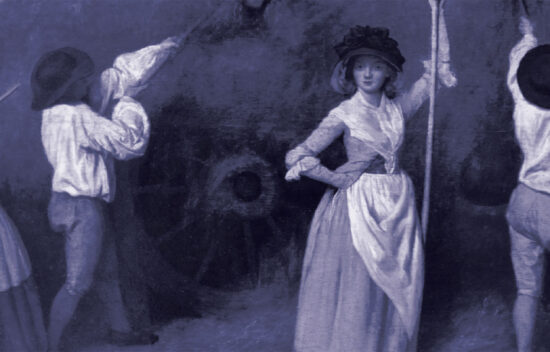
Women in Early America (1600-1800)
80 min
- Background Essay: Life in Early America
- Handout A: Equality and Voting Amendments
- Appendix A: Amending the Constitution
- Appendix B: Timeline and Quotes
- Appendix C: Timeline Cards
- Answer Key
- homogeneous
- coverture
- non-entities
- Republican Motherhood
- executor of a will
- benign neglect
- autonomy
FOR FURTHER READING
- Adams, Abigail. Letters, Library of America Adams Family Collection (2016)
- Berkin, Carol. Revolutionary Mothers: Women in the Struggle for America’s Independence (2006)
- Kerber, Linda “The Republican Mother: Women and the Enlightenment—An American Perspective” in Toward an Intellectual History of Women Durham: University of North Carolina Press (1997)
- Kerber, Linda. Women of the Republic: Intellect and Ideology in Revolutionary America (1997)
- Murray, Judith Sargent. “On the Equality of the Sexes” (1790)
- Norton, Mary Beth. Liberty’s Daughters: The Revolutionary Experience of American Women, 1750–1800 (1996)
- Rush, Benjamin. “Thoughts upon Female Education” (1787)
- Wollstonecraft, Mary. A Vindication of the Rights of Woman (1792)
- Read aloud some or all of following statements one at a time, adding your own that may better capture student interest. Sources for the more recent statements are provided at the end of the lesson. Begin with statements that are obviously describing cultures from the past. Do NOT indicate when you move to statements describing present-day. Do not read aloud the parenthetical note giving the location/time period; that information is provided for teacher background.
For each one, briefly ask students how they would judge that society based on that information.- A society routinely allows unwanted babies to die of exposure. (ancient Rome, others)
- A society keeps human beings as slaves. (Ancient Greece, Egypt, Rome, China, and most of the world for most of human history, including the United States through 1865)
- A society hangs people accused of witchcraft. (colonial New England)
- A society allows young children to work long hours in hot, dangerous factories. (19th century U.S. and many other parts of the world today)
- A society requires separate schools, travel accommodations, water fountains, and bathrooms for people of color than for whites. (Jim Crow era U.S; South Africa under apartheid)
- A society does not allow women to travel without a male guardian. (Saudi Arabia, present day)
- A society reports eliminating Downs Syndrome because all the women carrying fetuses with the chromosomal abnormality choose an abortion. (Iceland, present day).
- A society keeps young people, from the ages of 6-18, mostly sitting at desks inside for a majority of their day. (U.S., present day)
- A society imposes the death penalty for people of color at a higher rate than for white criminals. (U.S., present day)
- A society has more than 6,000 reported cases of human trafficking. (U.S., 2017)
- A society throws away 133 billion pounds of food a year even though people struggle with food insecurity both within that country and around the world. (U.S., present day)
- Explain that this was an exercise on historical thinking and humility, and the importance of not judging people of the past by modern standards. Why might certain practices still exist today, even though the overwhelming majority of people know they are wrong? Lead students to understand that even when people identify a wrong (i.e. slavery in the 1800s), that does not mean the practice will be immediately eradicated. It is easy to judge people of the past, but it requires humility to realize one’s own society is guilty of allowing injustices to continue. People like to think they would be the lone voice of reason standing against injustice.
- Offer the following points to wrap up the discussion:
- If an act is objectively wrong, such as murder or slavery, it is wrong whether “everyone else is doing it” or not.
- That said, cultural norms often prevent people from recognizing that an action is wrong.
- No society is immune from the tendency to assume their cultural norms are correct, and/or that they are more enlightened than those who lived in the past.
- Remember that people in the future are likely to look back with a critical eye at practices that are tolerated or even promoted today.
Activity I » 20 minutes
- Explain that historical thinking can help put the history of voting in the U.S. from the early republic to today in context.
- Distribute Handout A: Equality and Voting Amendments.
- Have students complete the worksheet independently, and then compare and revise by working in pairs or trios.
- Discuss students’ responses as a large group, having students record any new insights on their handouts. Then challenge students to independently write a summary statement about all the information at the bottom of the page.
Activity II and Wrap-Up » 20 minutes
- As a class, place each of the Appendix C: Timeline Cards on your class timeline.
- As you add the strips with the contributions of Hannah Griffitts, Phillis Wheatley, Mercy Otis Warren, Abigail Adams, and Judith Sargent Murray, call on a few students to share their responses to the Background Essay homework questions about these women.
- You may conclude that it is impossible to be sure how their legal status affected their ability to impact society (it might have motivated them to be more active, or it might have dissuaded them; it might have made others less apt to take them seriously, or it may have made their voices especially compelling).
- Use Appendix A: Amending the Constitution to consider the types of political participation available to women such as those described in this lesson.Consider the types of activities carried out by women like Abigail Adams, Griffitts, Warren, and Wheatley.
- Without the vote, to what extent and in what ways were these women able to influence the U.S. Congress?
- Without the vote, to what extent and in what ways were women able to influence their state legislatures?



